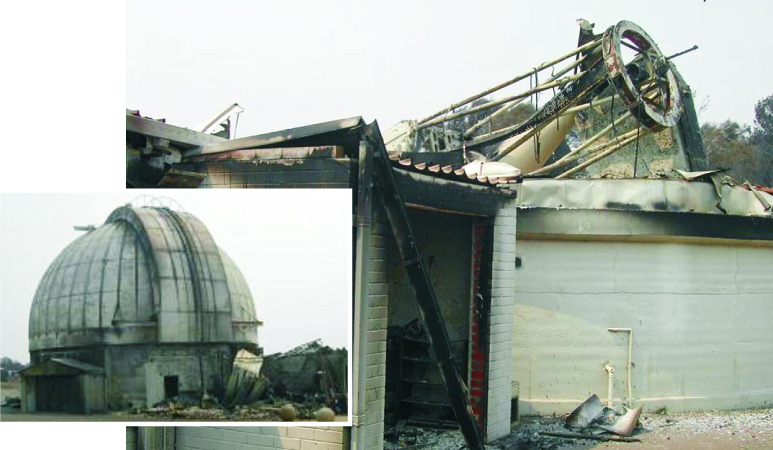Canberra Fire Destroys Observatory
DOI: 10.1063/1.1570768
The Australian National University’s Mt. Stromlo Observatory, near Canberra, Australia burned nearly to the ground on 18 January. The bush fires, which ravaged more than 1050 km2 of land, destroyed the observatory’s three domes, six telescopes, equipment workshops, eight staff houses, and an administration building. Preliminary estimates put the losses at more than AUD$20 million (roughly US$12 million) and are climbing.
The workshops held a nearly finished AUD$5 million imaging spectrograph for the Gemini North Telescope in Hawaii and initial work on a similar instrument for the Gemini South Telescope in Chile. Those losses may be hardest to deal with, says Brad Gibson of Swinburne University of Technology located in Victoria.
Penny Sackett, director of the observatory, adds, “Our losses felt overwhelming at the time, and the scene of Mt. Stromlo is one of devastation …, but we retained our most valuable asset, our staff, 100% intact, and we are extremely grateful for their safety.” Luckily, most of the 60 staff members and 20 students were away for the weekend; those who were there had less than 30 minutes to abandon the site before it was engulfed in flames.
Most of the observatory data survived, as did the designs for the Gemini instruments, states Sackett. Some observational programs, such as one to search for Kuiper Belt objects, will have to be abandoned, says Brian Schmidt, a Mt. Stromlo astronomer. “But we have not yet fully searched the 2.5 terabytes of data we have already taken, so it will not be a complete loss.” A multimillion-dollar plan to digitally image the southern sky will also have to be postponed “until we are able to build a replacement of the 50-inch telescope,” he adds.
The disaster prompted an outpouring of local, national, and international support, including an offer from the American Astronomical Society to help restock the Mt. Stromlo library. In mid-February, staff members returned to work and are living in temporary buildings until new facilities are constructed. The rebuilding began immediately and will take three years to complete. “The hardest part to replace will be the history,” says Schmidt. “The Australian national capital’s oldest building—the Oddie telescope—and others contained some of the best architectural examples of 1920s Australia.”
It’s likely that not all of Mt. Stromlo’s capabilities will be rebuilt at the same location. Light pollution from Canberra has caused viewing conditions to deteriorate at the observatory, and some replacement telescopes may be built at Siding Spring Observatory, located 600 km to the north. In either case, says Sackett, “the new Stromlo emerging from the ashes will be stronger and more resilient than that before the fires.”

The remains of one of the domes and the 50-inch telescope at Mt. Stromlo.
MATTHEW COLLESS, ANU

More about the Authors
Paul Guinnessy. American Center for Physics, One Physics Ellipse, College Park, Maryland 20740-3842, US . pguinnes@aip.org

